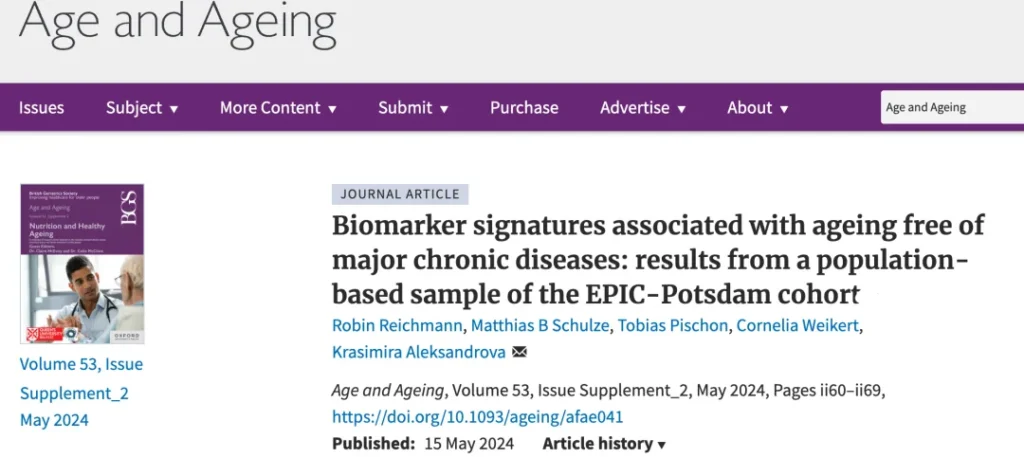As we reach middle age and beyond, what is the greatest happiness in life? Many people believe that “living a long life is the greatest happiness.” However, this statement is not entirely true. Imagine a person who lives a long life but suffers from constant illness — their later years may be filled with battles against diseases, which could feel more like a “burden” than a blessing. In fact, the greatest happiness in life is “not just living a long life, but living a healthy life.”
So, how can we live a long and healthy life? A recent study analyzing various physiological indicators has discovered that controlling just 4 key indicators can lead to a longer life with fewer illnesses as we age!
The Key to Longevity: 4 Key Indicators to Control
In May 2024, researchers in Germany published a study in the journal Aging and Geriatrics, identifying 4 critical physiological indicators that contribute to both longevity and healthy aging. By managing these 4 indicators, individuals can not only live longer but also remain disease-free in their later years.

Research screenshots
The study involved 2,500 participants aged between 20 and 67. The researchers analyzed blood samples from these participants, identifying 13 biomarkers related to various health factors such as glucose metabolism, lipid metabolism, liver function, kidney function, insulin sensitivity, and inflammation. Through their analysis, they found that 4 biomarkers were most strongly associated with “living long and healthy”:
- High-Density Lipoprotein Cholesterol (HDL-C): Known as “good cholesterol,” HDL-C helps transport cholesterol from peripheral tissues to the liver for metabolism. It is negatively correlated with cardiovascular risks, meaning the higher the HDL-C, the lower the risk of heart disease and atherosclerosis.
- Adiponectin: Often referred to as “the scout for early diabetes,” adiponectin is a protein secreted by fat cells. It enhances insulin sensitivity, regulates glucose and fat metabolism, and has anti-inflammatory and anti-atherosclerotic properties.
- Insulin-like Growth Factor Binding Protein 2 (IGFBP-2): IGFBP-2 binds to insulin-like growth factors, regulating their activity. It plays a role in improving metabolism, fighting atherosclerosis, and reducing the risk of neurodegenerative diseases.
- Triglycerides: Triglyceride levels are an important health indicator. High or low triglycerides can signal potential health problems. Elevated triglycerides often indicate lipid metabolism issues, such as dyslipidemia, which can be caused by poor diet, abnormal fat metabolism, or hyperlipidemia.

How to Control the Key Indicators for Longevity?
So, how can we manage these 4 “key indicators” in our daily lives? Researchers have identified 5 lifestyle habits that can help most people control these indicators effectively:
1. Healthy Diet
“You are what you eat.” Diet has a significant impact on our health. A long-term diet high in fats, salt, and sugar not only leads to obesity but also increases the risk of cancer and chronic diseases. A recommended diet is diverse, light on oils, and rich in vegetables, fruits, fish, seafood, dairy, and legumes. This kind of diet helps prevent nutrient deficiencies, obesity, and related chronic diseases, which ultimately leads to a longer life.
- Increase whole grains, reduce refined grains like white rice and white flour.
- Choose plant oils and cook at low temperatures.
- Opt for white meat (fish, shrimp, chicken) and reduce red meat (beef, pork, lamb). Soy products are also recommended.
- Eat plenty of vegetables and ensure a moderate intake of fruits.
- Include nuts and dairy in your diet.
- Prefer cooking methods like steaming, boiling, and poaching over frying.

2. Regular Exercise
“Life is movement.” Regular physical activity not only contributes to longevity and better metabolic health, but it also plays a crucial role in cancer prevention and lowering the risk of chronic diseases. The research team found that moderate-intensity physical activity can effectively delay aging and move you closer to becoming a “longevity elder.”
The most recommended exercise includes moderate-intensity activities, as low-intensity exercises are less efficient and high-intensity exercises can be too demanding. Common moderate-intensity exercises include brisk walking, light jogging, swimming, cycling, skipping rope, stair climbing, and yoga.

During moderate-intensity exercise, your heart rate should be between 100-140 beats per minute, and you should feel a slight sweat and slightly out of breath.
3. Maintain a Healthy Weight
Maintaining a healthy weight is crucial for keeping triglyceride levels in check and promoting metabolic health. Studies show that long-term obesity increases the risk of Alzheimer’s, cardiovascular diseases, and diabetes. To maintain a healthy weight, it’s recommended to check your weight weekly to spot any fluctuations early and adjust accordingly. A simple but effective way to combat aging is to eat lighter dinners and eat earlier. Research has shown that not eating after 5 PM helps fight aging, keeping the immune system young and supporting a healthier gut microbiome.

4. Avoid Smoking
Stay away from tobacco and secondhand smoke! Smoking is closely linked to accelerated aging and cancer. The free radicals produced during smoking damage cell membranes and healthy DNA, speeding up the aging process. A 2022 study published in the Journal of the American Medical Association confirmed the benefits of quitting smoking early: quitting before the age of 35 can fully “reverse” the death risk caused by tobacco. The mortality rate of smokers is 2.8 times higher than that of non-smokers, but quitters have a significantly lower death rate compared to those who continue smoking.

5. Maintain a Positive Mood
Managing emotions and stress is essential for longevity. Chronic stress has negative effects on inflammation and metabolism. Research has shown that a stressful lifestyle is linked to cardiovascular diseases, depression, obesity, and gastrointestinal problems.
If you’re feeling stressed or anxious, try spending time in natural environments such as parks. Studies have found that a one-hour walk in a park or urban green space can reduce brain activation in areas related to stress, helping to prevent anxiety and depression.

Conclusion
The key to a long, healthy life lies in controlling specific physiological indicators and adopting healthy lifestyle habits. By focusing on proper diet, regular exercise, maintaining a healthy weight, avoiding smoking, and managing stress, we can significantly improve our chances of living a long life free of chronic diseases. Keep these practices in mind and remember: health is the true form of longevity.



















